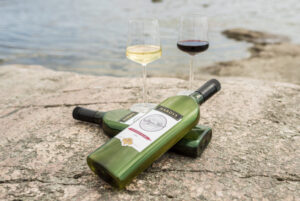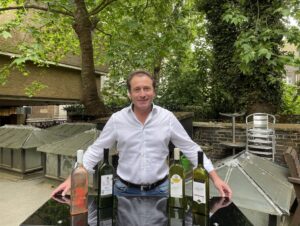Outside the box: Innovation reimagines wine packaging
When someone pictures wine, a standard image of a round glass bottle comes to mind. That, in Santiago Navarro’s estimation, is the problem.
Navarro, CEO and founder of London- based packaging company Packamama, has reimagined the wine bottle to benefit businesses, consumers and Mother Earth. Packamama’s flat wine packaging concept is sleek, convenient and made from 100% recycled PET, a feedstock that can be reprocessed and reused repeatedly.
“Wine is one of the first products sold across borders, which requires bottle packaging. We can go back several centuries, and we can go back even further before bottle packaging,” Navarro told Produce Processing. “There are historic vessels of many different forms that were used to transport wine. If we fast forward to today, most of the world of wine is still using a 19th-century product technology.”
It’s an outdated mode that makes even less sense in a modern world with increasing online commerce and lengthy, logistically challenging supply chains, Navarro said.
“If you started from scratch and came up with the base assumptions, smart ladies and men would say you want something that is lightweight, that’s strong, that looks beautiful, that’s low in emissions, that’s low in energy, that is spatially efficient,” he said. “Those would be the logical places where people would start. Then when you use those criteria to assess round glass bottles, one has to question why they’re still being used.”

Packamama’s packaging is inspired by three key elements: shape innovation, best-in-class material and recyclable by design. Modeled off traditional bottles, the flat containers are made in colors wine consumers are accustomed to, from olive green to rose pink.
“Wine is enjoyed at dining tables with friends and family, so trying it from a beautiful bottle that looks visually appealing is important, which is why we do create bottles that look good in the first place but are created in a way that is far better for a 21st-century world with long supply chains, global warming, all these complexities,” Navarro said.
A lighter footprint
Packamama calls to mind Pachamama, an Earth Mother-type goddess in Inca mythology who presided over planting and harvesting, and the benefits of the company’s bottles go beyond a pretty package. Its flat design allows up to 91% more product on a pallet in transport and warehousing, and that saved space reduces costs, cuts carbon emissions and requires fewer fuel- burning trucks on the road.

The lightweight bottle also requires less energy to make.
“It takes 255° C (about 500° F) to blow a PET bottle and 1,600° C to blow a glass bottle,” Navarro said. “That’s more than six times the temperature.”
Also, he said, “Our bottle requires 63 grams (2.2 ounces) of infeed material versus the average glass bottle (that) would be 500 grams and, in some cases, more.”
Recycled PET also cuts down on the emissions that come from brand-new plastic.
“PET in its virgin format comes from oil. If you’re using new oil, then you’re encouraging all the emissions related to the extraction of virgin oil,” Navarro said.
“But if you’re using above-ground carbon, then that’s already been expended and so is not calculated in your carbon footprint calculation.”
Altogether, the reimagined shape and recycled material result in a 50% emission savings, Navarro said. And, obviously enough, plastic bottles make for less waste because they don’t break like glass bottles and don’t require additional packing material to prevent breakage, taking up space and increasing shipping costs.
And there’s no need to worry about oxygen filtering through the plastic. Advanced barrier technology gives the wine a shelf life of 19-21 months.

Packamama began producing the flat bottles using injection stretch blowing in 2018. Sorting and processing technologies have come a long way in those five years, Navarro said, pointing to recent innovations in Australia as an example.
There, production partners collect bottles to send to a recycling plant, where they’re processed, palletized and blown into new bottles.
“It’s the lowest mechanism for producing packaging because you’re recycling pretty much one bottle into another new one. There’s very little loss of material,” Navarro said.
The wine industry should be especially motivated to lower its environmental impact, Navarro said, given its vulnerability to climate change.
“When the industry is at risk of massive reshaping because research shows that with two degrees of heating, 54% or 56% of the world of wine will be different, then we face a situation where wine must pull up its socks and do better to cut its carbon footprint,” he said.
And from a practical standpoint, environmental responsibility messaging goes over well with consumers, he added.
Sustaining shelf appeal
Since the Packamama bottles launched in the U.K., France and Australia, reaction has been mostly positive, Navarro said. Reviews on Packamama’s website compliment the bottle design and packaging performance, while one impressive endorsement is housed in Navarro’s London office overlooking the British Museum.
“Sitting in a cabinet on the outside of the office is a handwritten letter from Sir David Attenborough, who most would regard as the godfather of environmental awareness, who wrote me a letter to wish us all the best with our innovation,” Navarro said.

The durability and convenience of storing the flat bottles, which stand alone on tables or grocery shelves with a 5.5-degree tip angle and take up less refrigerator space, also seem to outweigh any initial balking from more traditionally minded consumers, Navarro said. He said a 2020 analysis of 1,000 posts on major social media channels found that 70% skewed positively toward the new design.
“We cannot remain any longer just saying, ‘Well, that’s the way we always did it so we must do it that way,’ ” Navarro said. “If that was the argument, then why would we have progressed from horses to engines?”
Packamama’s next move is a second and hopefully better-timed U.S. launch. Its first major push coincided with the beginning of the COVID-19 pandemic and resulting closures in February 2020. “At the end of 2020, our U.S. partner asked to pull the plug, which we did,” Navarro said. “It was simply the worst time to try and do this.”
Now in discussions with “one of the top supermarket groups and retailers in the U.S.,” Packamama is currently targeting an early 2024 launch, he said.
The U.S. market is an important one to Packamama as the company continues its mission to make wine in reimagined bottles with a lighter footprint.
“The ability to do in packaging what Ikea did in furniture is what drove me to come up with designs which were able to produce at large scale using the existing technologies but pushing them to the absolute limit,” Navarro said. “All these benefits make supply chains easier to work with and are better for business and better for the planet, but also far more convenient for customers.”
Editor’s note: A previous caption misidentified a bottle of wine. Pictured on the right is the Packamama design featuring Rio Claro in a green color traditionally associated with wine bottles. Photo: Packamama







